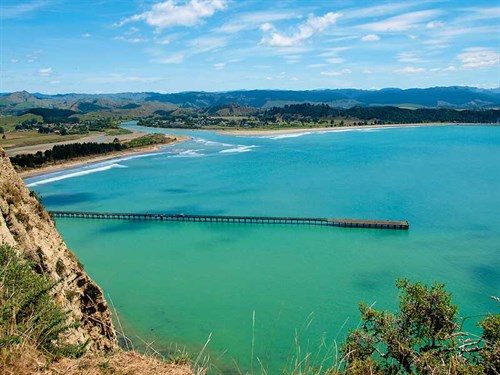
The date was 24 October, 1769, and it was the second time Lieutenant James Cook had stepped on to New Zealand shores.
At Tolaga Bay, the tangata whenua were accommodating and such was the bounty of food, water, and botanical specimens, the ship remained there for six days.
Two-hundred-and-forty-three years after Cook’s propitious footfall, I trudged along the walkway at the south end of the bay that leads to the cove where the HM Bark Endeavour hove to. In the early morning, beams of sunlight pierced through a lingering fog and, looking down on Cook’s Cove, it was easy to conjure up a shadowy vision of the small sailing ship riding at anchor, safe from moods of a capricious ocean. To the left rose a weathered, mitre-shaped rock. To the right Pourewa Island poked its shaggy head from the sea. Cook climbed high into the hills, maybe past the very one on which I stood.
“The valleys and sides of many of the hills were luxuriously clothed with woods and verdure…” he reported. “The country abounds with a great number of plants and the woods with as great a variety of very beautiful birds…”
It is a different sight today. From the higher hills along the walk, I looked north to an extensive view over Tolaga Bay. Much of the hinterland is stripped of its trees and a small town straddles the sluggish spread of the broad Uawa River. Birds were in short supply.
On the south side of the bay, near the beginning of the Cook’s Cove Walkway, stretches the longest wharf in the Southern Hemisphere. Its 660m length illustrates the importance of transport by sea in this part of the world when roads barely existed. To walk along this concrete relic, marvelling at its reach and admiring the hokey-pokey cliffs on its right flank, is one of the notable things to do on the East Cape. It is also worth noting that, due to a 20-year-long effort of a group of locals, the wharf has been saved when it could so easily have been left to crumble into the deep.
With a wide main street lined by fading buildings, Tolaga still has the look of a frontier town. Its squat profile is dominated by the two-storey, 120-year old, slightly gone-to-seed Tolaga Bay Inn at its northern end, built in an incongruous Elizabethan style. Locals are relieved that the new manager, Lilly Stender, is slowly restoring the pub’s reputation. It’s work in progress but is already looking better and the patronage for the garden bar and restaurant is growing.
The inn is a good place to catch a bit of local colour. You could be in the bay on a weekend when the pub is hosting a pig weigh-in, a cycle fitness rally, or a fishing or shearing competition. When hunger hits, you can go there anytime for a good steak or seafood chowder, unless you prefer a homemade pie from one of the two local bakeries, or what locals reckon are the freshest fish and chips in the east.
It’s hard to avoid the part Cook played in the area’s history. As well as Cooks Cove, all the streets in the town are named to remind us: Solander, Banks, Cook, Endeavour, Resolution, Discovery, Adventure, and Parkinson. I’m sure the great man could never have realised how significant his visit to Tolaga Bay was to become.






